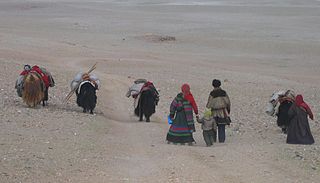
Tibet is a region in the central part of East Asia, covering much of the Tibetan Plateau and spanning about 2,500,000 km2 (970,000 sq mi). It is the homeland of the Tibetan people. Also resident on the plateau are some other ethnic groups such as the Monpa, Tamang, Qiang, Sherpa and Lhoba peoples and, since the 20th century, considerable numbers of Han Chinese and Hui settlers. Since the annexation of Tibet by the People's Republic of China in 1951, the entire plateau has been under the administration of the People's Republic of China. Tibet is divided administratively into the Tibet Autonomous Region, and parts of the Qinghai and Sichuan provinces. Tibet is also constitutionally claimed by the Republic of China as the Tibet Area since 1912.

Sikkim is a state in northeastern India. It borders the Tibet Autonomous Region of China in the north and northeast, Bhutan in the east, Koshi Province of Nepal in the west, and West Bengal in the south. Sikkim is also close to the Siliguri Corridor, which borders Bangladesh. Sikkim is the least populous and second smallest among the Indian states. Situated in the Eastern Himalaya, Sikkim is notable for its biodiversity, including alpine and subtropical climates, as well as being a host to Kangchenjunga, the highest peak in India and third highest on Earth. Sikkim's capital and largest city is Gangtok. Almost 35% of the state is covered by Khangchendzonga National Park – a UNESCO World Heritage Site.

Arunachal Pradesh is a state in northeast India. It was formed from the North-East Frontier Agency (NEFA) region, and India declared it as a state on 20 February 1987. Itanagar is its capital and largest town. It borders the Indian states of Assam and Nagaland to the south. It shares international borders with Bhutan in the west, Myanmar in the east, and a disputed 1,129 km border with China's Tibet Autonomous Region in the north at the McMahon Line. It is disputed by China and claimed as part of Tibet, although this claim is internationally unrecognized and India maintains its control over the state. China occupied some regions of Arunachal Pradesh in 1962 but later withdrew its forces.

Giuseppe Tucci was an Italian orientalist, Indologist and scholar of East Asian studies, specializing in Tibetan culture and the history of Buddhism. During its zenith, Tucci was a supporter of Italian fascism, and he used idealized portrayals of Asian traditions to support Italian ideological campaigns. Tucci was fluent in several European languages, Sanskrit, Bengali, Pali, Prakrit, Chinese and Tibetan and he taught at the University of Rome La Sapienza until his death. He is considered one of the founders of the field of Buddhist Studies.

The Changtang is a part of the high altitude Tibetan Plateau in western and northern Tibet extending into the southern edges of Xinjiang as well as southeastern Ladakh, India, with vast highlands and giant lakes. From eastern Ladakh, the Changtang stretches approximately 1,600 kilometres (990 mi) east into Tibet as far as modern Qinghai. The Changtang is home to the Changpa, a nomadic Tibetan people. The two largest settlements within the Tibetan Changtang are Rutog Town the seat of Rutog County and Domar Township the seat of Shuanghu County.

The Sino-Indian border dispute is an ongoing territorial dispute over the sovereignty of two relatively large, and several smaller, separated pieces of territory between China and India. The first of the territories, Aksai Chin, is administered by China as part of the Xinjiang Uyghur Autonomous Region and Tibet Autonomous Region and claimed by India as part of the union territory of Ladakh; it is mostly uninhabited high-altitude wasteland in the larger regions of Kashmir and Tibet and is crossed by the Xinjiang-Tibet Highway, but with some significant pasture lands at the margins. The other disputed territory is south of the McMahon Line, in the area formerly known as the North-East Frontier Agency and now called Arunachal Pradesh which is administered by India. The McMahon Line was part of the 1914 Simla Convention signed between British India and Tibet, without China's agreement. China disowns the agreement, stating that Tibet was never independent when it signed the Simla Convention.

Juniperus tibetica, the Tibetan juniper, is a species of juniper, native to western China in southern Gansu, southeastern Qinghai, Sichuan, and Tibet Autonomous Region, where it grows at high to very high altitudes of 2,600–4,900 metres. This species has the highest known elevation treeline in the northern hemisphere.

The following outline is provided as an overview of and topical guide to Tibet:
The Sarvatathāgatatattvasaṃgraha sutra, also known as the Tattvasaṃgraha Tantra, is an important seventh century Indian Buddhist tantric text. Although the scripture refers itself as a Mahayana sutra, the content is mainly tantric in nature and thus is sometimes called a tantra. This work is an important source for the Shingon tradition.

The 14th Dalai Lama, known to the Tibetan people as Gyalwa Rinpoche, is, as the incumbent Dalai Lama, the highest spiritual leader and head of Tibet. He is considered a living Bodhisattva; specifically, an emanation of Avalokiteśvara in Sanskrit, and Chenrezig in Tibetan. He is also the leader and a monk of the Gelug school, the newest school of Tibetan Buddhism, formally headed by the Ganden Tripa. The central government of Tibet, the Ganden Phodrang, invested the Dalai Lama with temporal duties until his exile in 1959.

Lochen Rinchen Zangpo, also known as Mahaguru, was a principal lotsawa or translator of Sanskrit Buddhist texts into Tibetan during the second diffusion of Buddhism in Tibet, variously called the New Translation School, New Mantra School or New Tantra Tradition School. He was a student of the famous Indian master, Atisha. His associates included (Locheng) Legpai Sherab. Zangpo's disciple Guge Kyithangpa Yeshepal wrote Zangpo's biography. He is said to have built over one hundred monasteries in Western Tibet, including the famous Tabo Monastery in Spiti, Himachal Pradesh, Poo in Kinnaur and Rinchenling monastery in Nepal.
Littledalea is a genus of Asian plants in the grass family, native to mountains in China and neighboring countries. The genus is placed in its own tribe Littledaleae within subfamily Pooideae. The isolated tribe seems to be sister to the tribes Bromeae and Triticeae.

Roscoea tibetica is a perennial herbaceous plant native to the mountains of China, being found in Tibet, Sichuan and Yunnan. The species formerly included plants found in Bhutan; in 2000, these were separated into a new species, Roscoea bhutanica. Most members of the ginger family (Zingiberaceae), to which it belongs, are tropical, but R. tibetica, like other species of Roscoea, grows in much colder mountainous regions. R. tibetica is sometimes grown as an ornamental plant in gardens. In 2020, it was proposed that R. tibetica be split again.

Roscoea bhutanica is a perennial herbaceous plant native to the mountains of Bhutan and Tibet. Formerly regarded as part of Roscoea tibetica, it was recognized as a separate species in 2000. Most members of the ginger family (Zingiberaceae), to which it belongs, are tropical, but R. bhutanica, like other species of Roscoea, grows in much colder mountainous regions.

Lancea is a plant genus in the recently described Mazaceae. It had formerly been tentatively included in the lopseed family, Phrymaceae as well as the Scrophulariaceae.
Morchella tibetica is a species of fungus in the family Morchellaceae. Described as new to science in 1987, it is found in Tibet, where it grows in deciduous woodland.

Tibet–India relations are said to have begun during the spread of Buddhism to Tibet from India during the 6th century AD. In 1959, the Dalai Lama fled to India after the failed 1959 Tibetan uprising. Since then, Tibetans-in-exile have been given asylum in India, with the Indian government accommodating them into 45 residential settlements across 10 states in the country, creating the Tibetan diaspora. From around 150,000 Tibetan refugees in 2011, the number fell to 85,000 in 2018, according to government data. Many Tibetans are now leaving India to go back to Tibet and other countries such as United States or Germany. The Government of India, soon after India's independence in 1947, treated Tibet as a de facto independent country. However, more recently India's policy on Tibet has been mindful of Chinese sensibilities, and has recognized Tibet as a part of China.

Tibet Autonomous Regional People's Government is the provincial administrative agency of Tibet, People 's Republic of China. The provincial government consists of the Tibet Autonomous Regional People's Congress, the TAR People's Congress Standing Committee, and has a mandate to frame local laws and regulations, such as the use of the Tibetan language in the region. Additionally, rules for adapting national laws to the province are also the responsibility of the People's Government.
Silene tibetica is a species of plant which is a member of the family Caryophyllaceae. The species can be found in Tibet.
Hedinia is a monotypic genus of flowering plants belonging to the family Brassicaceae. It only contains one known species, Hedinia tibetica.















